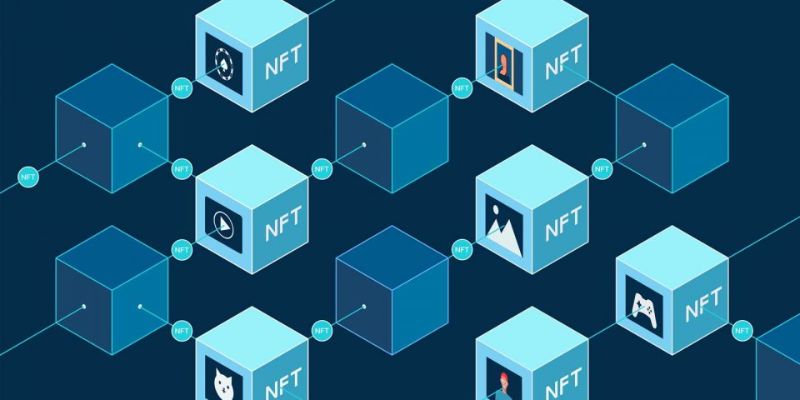What is blockchain technology? Imagine a world where your online deals are safe, no one can cheat, and everyone agrees on a clear set of rules. That’s the power of blockchain. It’s not just for tech wizards anymore; it’s changing how we handle our money, track goods, and even keep our health records safe. Let’s dive in and see how this tech makes it all happen and could change our lives for the better.
Understanding Blockchain Technology Fundamentals
Exploring the Concept of Distributed Ledger Technology
Imagine a book where you write all your friends’ debts and loans. Now, imagine this book is copied across a whole network of computers. This book is now a digital, public ledger. We call this ledger a blockchain. It is the core of distributed ledger technology.
When someone makes a transaction, like sending money, this transaction is a new ‘block’. Computers then approve and add it to the ‘chain’ of other blocks. This process ensures that everyone who has a copy of the ledger always has the latest version. This makes it hard to cheat or change past records.
How Cryptographic Hashing Underpins Security
Now, let’s talk safety. Each block has its own unique secret code, known as a hash. If someone tries to change a transaction, the block’s hash changes. Remember, all blocks are linked together. So, changing one block would mess up the whole chain. This unique securing method is called cryptographic hashing.
The beauty of blockchain is that it’s very secure without a boss holding keys to the castle. Instead of one person keeping our transactions safe, the whole network does. If you’ve heard of Bitcoin or Ethereum, they’re like digital gold mined using this technology.
Blockchain is not just about money. It’s also being used in supply chains, voting systems, and even to confirm who we are online. It’s like a swiss army knife for the digital age. It’s a platform where you can build many tools – like smart contracts. These are agreements that automatically do what they say once conditions are met.
In summary, blockchain is a transparent, secure way to save and see transactions. It’s the backbone of cryptocurrencies but has many more uses. With its clever design, it helps us trust each other in an age where we do more and more online.

Delving into Blockchain’s Core Mechanisms
The Role and Function of Smart Contracts
Imagine you’re making a deal with some friends. You all agree on the rules, shake hands, and trust everyone to do their part. Now, think of smart contracts like a digital handshake with rules that a computer follows. These smart contracts live on the blockchain, which is like a massive digital book that everyone can read but no one can erase or change. When people say “blockchain,” they mean this secure, shared record book.
Smart contracts help make sure everyone sticks to the deal. They run on their own when the rules are met, without anyone having to check up on them. This cuts out middlemen, saving time and money. For example, on the Ethereum platform, you can create a smart contract to automatically pay rent each month, and it’ll do just that, as long as you have the funds.
Analyzing Consensus Protocols: Proof of Work vs. Proof of Stake
On a blockchain, every member’s computer, or “node,” has to agree on the records. But how do we make sure that no one messes with the data? That’s where consensus protocols come in – they’re the rules that all the nodes follow to agree on updates to the blockchain.
There are two main kinds: proof of work and proof of stake.
Proof of work is like a race. Nodes, or miners, use a lot of computing power to solve complex math puzzles. The first to finish gets to add a new block of transactions to the chain and is rewarded with cryptocurrency. Bitcoin uses this method. It’s safe and tried-and-true, but it uses a ton of energy.
Proof of stake, on the other hand, works more like a lottery. The more cryptocurrency you’re willing to “stake,” or lock up, the better your chances are to be chosen to add a new block to the chain. It’s like saying, “I have a lot of coins, so you can trust me not to cheat.” It uses far less electricity than proof of work and is getting popular with newer blockchains.
Both these systems help keep the blockchain secure and make sure everyone agrees on what’s in the digital record book – without needing a boss to decide. This gives us a way to make deals and move money across the internet, trusting in math and code instead of people, which can be a game-changer for doing business or sending money around the world.

Blockchain’s Impact Across Industries
Revolutionizing Finance with Decentralized Systems
Let’s dig into how blockchain is changing money stuff. People trust banks to hold and move their cash, right? Now think about a bunch of computers agreeing on who owns what. No bank needed. This is blockchain. It’s a powerful tool that does finance differently. It uses something called distributed ledger technology, or DLT, to spread out data across many places. This means everyone can see and agree on all moves made, keeping everything open and fair. It’s like a game where everyone sees all the moves, so no one can cheat.
This tech is huge for things like Bitcoin. Bitcoin is a type of digital cash that runs on blockchain. So when you hear about cryptocurrency foundations, that’s the base of digital money like Bitcoin. The blockchain for Bitcoin records every deal on lots of computers, making it tough to mess with. A big win here is that money moves faster and cheaper across the world.
Enhancing Supply Chain Transparency and Efficiency
Now let’s talk supply chain. This is about getting products from where they’re made to where they need to go. Blockchain makes this smoother by keeping a clear list of each step. This list is secure and shared on a vast peer-to-peer network. Everyone from the maker to the buyer sees the product’s journey. It’s like tracking a package, but way more detailed.
Companies dig this because it cuts down lies and mix-ups in goods tracking. Plus, if something goes wrong, they can spot the hiccup fast. Smart contracts also play here – they’re like self-working deal papers. They seal an agreement safely when conditions are met. This helps in making deals and moving goods without hold-ups.
Blockchain databases stack up record bits in blocks. Once a block fills up, it links to the last one, forming a chain. That’s why messing with just one record won’t work; it changes the whole chain’s look, tipping everyone off. With blockchain, the trust sits in the math and the system, not just in people.
In short, blockchain isn’t just tech talk. It’s shaping up the nuts and bolts of how things work, from our money to our malls. As more folks learn about blockchain, companies are jumping in to see how it can work for them. It’s not just for geeks or money pros. It’s a new, smarter way to do everyday business. And that’s something to get excited about.
Remember, this fresh take on tracking and deals is not far out – it’s happening now, and it’s pretty cool! It’s like a magic ledger making things better all around, and it’s just getting started.
Addressing the Challenges and Future of Blockchain
Overcoming Scalability Issues for Wider Adoption
Blockchains are like digital ledgers. They store records for all to see. Masters of this system are everywhere. They watch over the data to keep it safe. But there’s a problem: as more people use blockchains, they can get slow. Why? Because every new piece of data must reach all corners of this vast system. This process takes time, especially when there’s a lot to share.
So, how do we make blockchains faster? Let’s get to work on this. First, we improve the code that runs it all. New updates can help speed things up. Also, we can change the rules for checking transactions. This way, data moves like a sprinter, not a snail. But remember, we have to be careful not to break the trust that makes blockchains strong.
Another bright idea is like making a second floor in a building. We can build new layers on top of the basic blockchain that can handle more weight. These layers can manage many transactions at once before adding them to the main ledger. This could really help us run faster.
Let’s not forget, some people are trying out whole new blockchains too! They think starting fresh could fix the slow problem. They could be right, but it will take time to see if their new systems work well.

Blockchain Innovations and the Rise of Digital Healthcare Solutions
Imagine if your doctor could see your health records in a flash. No more waiting for papers. It could be possible with blockchain tech in healthcare. Here’s how it could work. All your health info could be put into a blockchain. Only people you say can see it, would see it. It’s like giving a key only to folks you trust.
Why use blockchain in healthcare? It’s all about keeping things in order and safe. When your records are in a blockchain, no one can mess with them. They’re locked down tight. No one can change them unless you say so. Plus, it’s not just stuck in one place. Doctors everywhere could see your locked-up info if you let them.
There are smart contracts too. These are like promises in code. They follow rules you set to protect your health data. They can also help you share your info really fast when needed.
People are working on this right now. There are new projects where each patient’s data is a block in the chain. It’s challenging, sure, but it’s very exciting too. If done right, you could have more control over your health info. Your data would be private and easy to share with the right people when it counts.
So, what does all this mean? It means blockchains have growing pains. They need to handle lots of data fast if more folks are going to use them. And in healthcare, they could change the game. They could help keep our health records safe, private, and ready to use. This is how we’re moving forward, making sure blockchains can hold the weight and keep our lives on the right track.
We’ve just explored the world of blockchain, from its basic setup to its big impact on businesses today. We started by breaking down the basics: how blockchain stores data across many places and keeps it super safe with complex math. Then, we dove into what makes blockchain tick—smart contracts that seal deals without a middleman, and different ways of agreeing on what’s what in the blockchain world.
We saw how blockchain is changing the game in money matters and making sure things we buy come from where they say they do. But it’s not all smooth sailing. There are some bumps, like making sure blockchain can handle loads of users without slowing down. Plus, we’re seeing exciting new ways blockchain can help keep us healthy by making patient info super secure.
To wrap up, blockchain is more than just tech talk—it’s a game-changer. It’s got hurdles to jump, sure, but the future looks bright. It’s an exciting time to see where blockchain will go next!
Q&A :
What exactly does blockchain technology entail?
Blockchain technology is a decentralized digital ledger that records transactions across many computers so that the recorded transactions cannot be altered retroactively. It underpins systems like cryptocurrencies, enabling secure and transparent peer-to-peer transactions without the need for a central authority like a bank or government.
How does blockchain technology work under the hood?
At its core, blockchain technology creates an immutable chain of data blocks. Each block contains a number of transactions that, once confirmed, are linked to the previous block, forming a chain. This is done using cryptographic principles to ensure that once data is entered, it cannot be erased or altered, thereby ensuring the integrity and verifiability of the entire chain.
Can blockchain be used beyond cryptocurrency applications?
Yes, while blockchain is the foundation for cryptocurrencies such as Bitcoin, its potential uses extend far beyond that. Blockchain can revolutionize various sectors including supply chain management, healthcare, finance, voting systems, and more. It offers a secure and transparent way to track the ownership of assets, manage records, and ensure the authenticity of information.
What are the main advantages of using blockchain technology?
Blockchain technology offers several advantages such as increased security, improved transparency, reduced transaction costs, and the elimination of middlemen. It facilitates faster transactions, enhances traceability for supply chains, and provides an immutable record that is nearly impossible to hack or manipulate.
Are there any limitations or challenges associated with blockchain?
While blockchain boasts numerous benefits, it’s not without its challenges. The technology faces issues such as scalability, as the increasing number of transactions can slow down the network. There are also concerns over regulatory challenges, energy consumption by some blockchain versions (especially those that require mining), and integration with existing financial systems.


